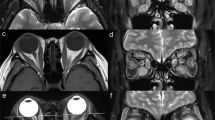Abstract
Objective
A promising radiopharmaceutical 99mTc-HYNIC-TOC (99mTc-HYNIC-Octreotide) can be applied for somatostatin receptor scintigraphy with the potential to replace Indium-111 labeled somatostatin analogus. Here we evaluate whether orbital 99mTc-HYNIC-TOC scintigraphy can be used as a Graves’ ophthalmopathy (GO) activity parameter to predict the retrobulbar irradiation response.
Methods
Orbital 99mTc-HYNIC-TOC scintigraphy was performed on 14 consecutive patients demonstrating moderated to severe Graves’ ophthalmopathy. The patients were treated with retrobulbar irradiation following the octreoscan and the response to this therapy was assessed at 3 months after the start of treatment. The orbital 99mTc-HYNIC-TOC uptake was calculated to assess the effects of treatment.
Results
Among the 14 GO patients, eight (57.1%) responded to retrobulbar radiotherapy; six (42.9%) showed no change. We compared the eight responders and six non-responders in terms of orbital 99mTc-HYNIC-TOC uptake, using the orbital/occipital ratio. On the 4-h 99mTc-HYNIC-TOC scintigraphy, responders had a higher orbital/occipital uptake ratio than the no-responders (P = 0.001). A significant correlation was found between the orbital/occipital ratio and the clinical activity score (CAS) (P = 0.034). The Receiving-Operator-Characteristic curve showed the best threshold for discriminating active and inactive disease was 1.40 (sensitivity, 100%; specificity, 83.3%). In the responders group, all these eight patients had positive scintigraphy. While there were five patients who had negative scintigraphy in the non-responders group.
Conclusion
Orbital 99mTc-HYNIC-TOC scintigraphy can be a useful method for the estimation of disease activity and prediction the response to subsequent radiotherapy in GO patient. And the patients with positive octreoscan were more likely to respond to irradiation.



Similar content being viewed by others
References
L. Bartalena, A. Pinchera, C. Marcocci, Endocr. Rev. 21, 168–199 (2000)
P.M. van Hagen, E.P. Krenning, D.J. Kwekkeboom, J.C. Reubi, P.J. Anker-Lugtenburg, B. Lowenberg, S.W. Lamberts, Eur. J. Clin. Invest. 24, 91–99 (1994)
L. Galuska, A. Leovey, Z. Szucs-Farkas, L. Szabados, I. Garai, A. Berta, E. Balazs, J. Varga, E.V. Nagy, Nucl. Med. Commun. 26, 407–414 (2005)
G. Burggasser, I. Hurtl, W. Hauff, J. Lukas, M. Greifeneder, B. Heydari, A. Thaler, A. Wedrich, I. Virgolini, J. Nucl. Med. 44, 1547–1555 (2003)
M. Parisella, C. D’Alessandria, B. van de Bossche, M. Chianelli, G. Ronga, E. Papini, R. Mikolajczak, C. Letizia, G. De Toma, A. Veneziani, F. Scopinaro, A. Signore, Cancer Biother. Radiopharm. 19, 211–217 (2004)
A. Plachcinska, R. Mikolajczak, H.R. Maecke, A. Michalski, K. Rzeszutek, J. Kozak, J. Kusmierek, Eur. J. Nucl. Med. Mol. Imaging 31, 1005–1010 (2004)
C. Decristoforo, S.J. Mather, W. Cholewinski, E. Donnemiller, G. Riccabona, R. Moncayo, Eur. J. Nucl. Med. 27, 1318–1325 (2000)
S.C. Werner, J. Clin. Endocrinol. Metab. 44, 203–204 (1977)
M.P. Mourits, M.F. Prummel, W.M. Wiersinga, L. Koornneef, Clin. Endocrinol. (Oxf) 47, 9–14 (1997)
A. Pinchera, W. Wiersinga, D. Glinoer, P. Kendall-Taylor, L. Koornneef, C. Marcocci, H. Schleusener, J. Romaldini, H. Niepominiscze, S. Nagataki, M. Izumi, Y. Inoue, J. Stockigt, J. Wall, F. Greenspan, D. Solomon, J. Garrity, C.A. Gorman, Thyroid 2, 235–236 (1992)
L. Bartalena, C. Marcocci, F. Bogazzi, L. Manetti, M.L. Tanda, E. Dell’Unto, G. Bruno-Bossio, M. Nardi, M.P. Bartolomei, A. Lepri, G. Rossi, E. Martino, A. Pinchera, N. Engl. J. Med. 338, 73–78 (1998)
S.L. Trokel, F.A. Jacobiec, Ophthalmology 88, 553–564 (1981)
M.F. Prummel, W.M. Wiersinga, Thyroid 5, 231–234 (1995)
M.P. Mourits, L. Koorneef, W.M. Wiersinga, M.F. Prummel, A. Berghout, R. Van der Gaag, Br. J. Ophthalmol. 73, 639–644 (1989)
I. Sillaire, A. Ravel, H. Dalens, J.M. Garcier, L. Boyer, Br. J. Radiol. 84, 139–142 (2003)
E. Mayer, G. Herdman, C. Burnett, J. Kabala, P. Goddard, M.J. Potts, Eye 15, 313–318 (2001)
M.N. Gerding, M.F. Prummel, W.M. Wiersinga, Clin. Endocrinol. (Oxf) 52, 641–646 (2000)
P.T. Postema, E.P. Krenning, R. Wijngaarde, P.P. Kooy, H.Y. Oei, W.A. van den Bosch, J.C. Reubi, W.M. Wiersinga, H. Hooijkaas, T. van der Loos, J. Clin. Endocrinol. Metab. 79, 1845–1851 (1994)
R. Moncayo, I. Baldissera, C. Decristoforo, D. Kendler, E. Donnemiller, Thyroid 7, 21–29 (1997)
M.N. Gerding, F.M. van der Zant, E.A. van Royen, L. Koornneef, E.P. Krenning, W.M. Wiersinga, M.F. Prummel, Clin. Endocrinol. (Oxf) 50, 373–379 (1999)
G.E. Krassas, A. Dumas, N. Pontikides, T. Kaltsas, Clin. Endocrinol. (Oxf) 42, 571–580 (1995)
G. Kahaly, R. Gorges, M. Diaz, G. Hommel, A. Bockisch, J. Nucl. Med. 39, 533–536 (1998)
H.B. Burch, L. Wartofsky, Endocr. Rev. 14, 747–793 (1993)
C. Marcocci, L. Bartalena, F. Bogazzi, M. Panicucci, A. Pinchera, Acta Endocrinol. (Copenh) 120, 473–478 (1989)
A.F. Karlsson, K. Wetermark, P.A. Dahlberg, R. Jansson, P. Enoksson, Lancet 2, 691 (1989)
A.W.C. Kung, C.C. Yau, A. Cheng, J. Clin. Endocrinol. Metab. 79, 542–546 (1994)
Acknowledgments
The present study would not have been possible without the participation of the patients and control volunteers. The study is supported by the grants from National Nature Science Foundation of China (No. 30370666).
Author information
Authors and Affiliations
Corresponding author
Additional information
Hua Sun and Xu-Feng Jiang contribute equally to this article.
Rights and permissions
About this article
Cite this article
Sun, H., Jiang, XF., Wang, S. et al. 99mTc-HYNIC-TOC scintigraphy in evaluation of active Graves’ ophthalmopathy (GO). Endocr 31, 305–310 (2007). https://doi.org/10.1007/s12020-007-0039-2
Received:
Revised:
Accepted:
Published:
Issue Date:
DOI: https://doi.org/10.1007/s12020-007-0039-2




